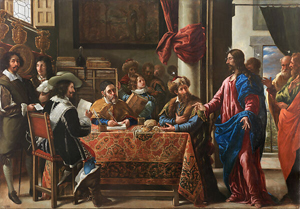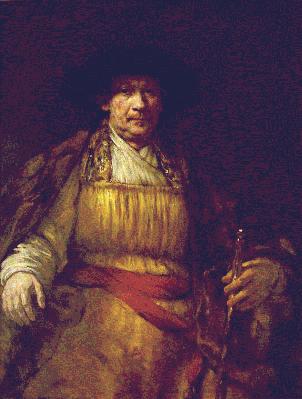Celebrations of Deliverance
John Haberin New York City
Juan de Pareja and Diego Velázquez
Esther in the Age of Rembrandt
In 1650, a Spanish gentleman brought his slave to Italy on a mission from the king. Spain was a world power, and this was its Golden Age.
It no longer posed a threat to England, not since the defeat of the Spanish Armada in 1588, and it had ceded independence to the Dutch. Yet its influence extended everywhere, from Europe to the New World, and that influence depended on slavery. At court as well,  black Africans and Muslims forcibly converted to Christianity kept the festivities going as never before. Is it any wonder that Diego Velázquez had a slave to call his own?
black Africans and Muslims forcibly converted to Christianity kept the festivities going as never before. Is it any wonder that Diego Velázquez had a slave to call his own?
No prouder subjects
Velázquez, though, had no interest in the slave trade or sugar plantations overseas. He could not so much have styled himself a gentleman had he not changed the rules of the game. He was a painter, whose portraits of Philip IV and the pope show his intimacy with world leaders and an unmatched demand for his work. And his slave changed the rules for himself, too. A free man on his return to Spain, Juan de Pareja became a leading painter in Madrid, perhaps the leading painter, after the death of his master in 1660. With "Juan de Pareja: Afro-Hispanic Painter" the Met teases out two tangled lives and their ascending careers.
The experience has a tour guide, with a mini-exhibition of his own. Arturo Schomburg began the hunt for Pareja a century ago, in the Harlem Renaissance. For Schomburg, the hunt was personal at that, and he called a book The Negro Digs Up His Past. His was a complicated past at that, from a native Puerto Rican with an admirably mixed ancestry I shall leave to you to discover. In Avilla, he took photographs that, with his handwritten legends, evoke the streets that Spanish artists once knew and that even now lay before his eyes. Yet what lies before one's eyes today is more pressing still.
I pick up the story in a moment, but Pareja was not the only one seeking freedom from Baroque Spain. An entire nation rested its identity on just that, with biblical authority to back it up. And that means a good story. I can hear a voice even now, and it could be talking about New York. It tells of a city, a port city, open to the world. You can find pretty much anything here and anyone.
It is a prosperous city and an educated one, although not everyone speaks the same language. It is always under construction, with an eye to creating public spectacles and public spaces, and housing does not welcome everyone everywhere. It has, if anything, too many artists. Above all, it values diversity and tolerance where other states may not, with no shortage of synagogues to match. As happens, though, it is Amsterdam, the city of "The Book of Esther in the Age of Rembrandt," at the Jewish Museum through August 10. Now what happens if everyone here claims the Bible's lessons as one's own?
The Book of Esther has that rarity in the Hebrew Bible, a happy ending, but with conditions. It is a tale of threats, deliverance, and celebration, and Amsterdam had every right to celebrate. It had at last won its freedom from Spain, as a republic, in time for the great age of Dutch painting, and it saw Esther as about nothing less. History often singles out Rembrandt for his sympathy for Jews, Ashkenazi and Sephardic, and he lived in a quarter that they, too, occupied—although that may have had more to do with an artist's income and with official decrees limiting Jewish life while guaranteeing freedom of worship. Prints of Rembrandt's wife, Saskia, have come to be known as The Jewish Bride. Here, though, the city takes credit.
A Jewish heritage, I might argue, is divided over Esther, too. After the fall of Israel, the Babylonian captivity, and a second conquest by still another empire, Persia, Jews were at last free to go home, but should they, and where is home? Should it lie in a capital for all the people, with the temple and its sacrifices? Or should it lie in the word of God and the law wherever they may be? Where the books of Ezra and Nehemiah demand a community apart, Esther is about living under foreigners, even marrying one. It might speak to the Dutch—or to New Yorkers today.
A gentleman and a slave
Forgive Diego Velázquez if he holds center stage. So fine an artist can hardly help it, and his influence is everywhere—most notably on his former slave, workshop assistant, and pupil. With the Hispanic Society in upper Manhattan closed for restoration and the Met's European painting galleries for its "skylight project," a room for Velázquez in its Lehman wing would be no mean show to itself. (The Met's Dutch painting hangs downstairs.) A corridor just outside looks at images of slavery in Spanish art, a second at the Madrid school, including Juan de Pareja. You can easily race past them as mere background music to work at hand.
Yet Pareja shares center stage, too. Velázquez set up a studio in Rome, where he painted Pareja as every inch a gentleman. The Met purchased the portrait for $4.5 million in 1971, well before the art world went crazy, and it made headlines. He has no prouder subject. Pareja's loose dark hair, intense eyes, slightly open lips, and a hand covering his heart speak of freedom, reserve, and an active mind. His lace collar and resplendent flesh catch the light. The curators, David Pullins with Vanessa K. Valdés of City College, quote Julie Mehretu, herself an African American painter worth remembering, who wonders at how Velázquez could convey so much humanity while denying his slave just that.
And every word of that is true, but so is something more. Velázquez and Pareja were reinventing humanity. Bartolomé Esteban Murillo paints Three Boys, nominally equals, with the black boy at top center. Yet there is no denying that he is a servant at work while the others play, which a sickly grin and Murillo's sentiment do nothing to hide. Velázquez goes further—painting a kitchen maid thrice over (counting two disputed copies) with no doubt of her inherent worth or painful status. Her unsmiling face in the darkness attests to dignity and bitter experience.
Velázquez came to Italy to case out art for a king, but also for his own enlightenment. Could he have seen a budding talent by his side that deserved the same? Pareja (whose origins and ancestry no one knows) would have ground pigments and prepared canvas, painting little or nothing, but then so would any assistant. True, he remained a slave until 1654, but he received his walking papers just months after his portrait. He would have faced only exclusions, debt, and enslavers traveling on his own. With Velázquez, every door was open, even where he could not walk through.
But he did walk free, and within a few years he had found his footing. It did not look promising at first. The Met attributes to him a copy of the older artist's portrait of King Philip, but with a sketchy mustache, a face without anatomy or character, and a mushy, uniform background. Still, museums feel the pressure to upgrade attributions, and this one could be no more legit. Pareja was at his best on his own and as something of a showoff, through his death in 1670. It set the tone as well for a shallower, but no less impressive version of the Baroque in its second half century.
Pareja positions himself at far left of The Calling of Saint Matthew, much as Velázquez takes his place among the nobility in The Surrender at Breda. He holds a document as his signature, with a proud F (Latin for fecit, or "he made it"), and paints the same on painted stone in a second painting, as if carved there. He is showing off just as much with the gold that Matthew, the tax collector, holds dear or the apostles who all but overshadow Jesus. John the Baptist gets a few extra episodes from life along with The Baptism of Christ, because there can never be enough. Besides, a baptism is a new beginning. For a black man, it was well overdue.
Claiming the Bible
Do Jews celebrate on Purim to remember their deliverance from a royal decree of death? The Jewish Museum opens with a room for both aspects of remembrance, the story and the place. It has scrolls of the book of Esther, one of the Old Testament's shortest, to be read aloud on the holiday, and stone fireplace guards with images. It has Delft tiles and silver to help in getting drunk, as the occasion dictates. It has prints of synagogues and a public square with a new town hall in progress. No one seems to be merely idling or, conversely, in a hurry passing through.
Only slowly do paintings take over the story, and they never stop. Near the end, a wooden chest bears small paintings of Esther, enough to call it a book in itself. Do Flemish artists also tackle Esther with crisper, shinier colors?  So much for the exhibition's political history, but then they do reflect a greater hierarchy of kings and attendants. A prominent Dutch painter, Jan Steen, illustrates the tale's climactic revelation three times. He, too, has brighter lights, along with hokier gestures but a gift for composition.
So much for the exhibition's political history, but then they do reflect a greater hierarchy of kings and attendants. A prominent Dutch painter, Jan Steen, illustrates the tale's climactic revelation three times. He, too, has brighter lights, along with hokier gestures but a gift for composition.
Above all, here comes the circle of Rembrandt, especially a late student, Aert de Gelder. He can imitate his teacher's bulky fabrics filling out the promise of female anatomy, but not the softer outlines and inward-directed eye. Where his Esther looks up, toward her god, or to the king, Rembrandt's looks nowhere but within. So he does, too, in a self-portrait on loan from the Isabella Stewart Gardner Museum in Boston (which lost a Rembrandt years ago to a still unsolved theft along with a Vermeer), at age a mere twenty-three. Its firm but parted lips speak of a young man's confidence and a trembling inner light. The misty darkness of Rembrandt's late portrait at the Frick Collection is still to come.
That leaves a major gap, Rembrandt's Bible. You may well wonder where to find it, but the show has a whole room for a standing Esther simply thinking. It is a fraught moment. You may recall that Haman, an advisor to King Ahasuerus, takes offense when a Jew, Esther's cousin Mordecai, refuses to bow to someone other than the one true god—and in return extracts a death sentence for the Jews. Offended that his wife did not show proper obedience either, Ahasuerus ditches her in favor of Esther, without knowing Esther's faith. In the painting, she is preparing to tell him.
She will do so, obtaining a death sentence for Haman and a promise of deliverance, although it is a complicates story. (Can Ahasuerus go back on his own word?) And paintings mostly zero in the confrontation, with the bad guy in darkness and the king in the light. Rembrandt shows only Esther and an elderly attendant, and here the older woman is lost in shadow, while Esther is lost in her fears, in her determination, and in thought. Anticipation becomes drama. Rembrandt, around age thirty, has a lot of thinking to do himself.
Still, a large exhibition has a hole at its very center, and there is no getting around it. Not even Rembrandt, largely in his absence, can steal the show. The curators, Abigail Rapoport with Michele L. Frederick, does have a 1992 painting by Fred Wilson, who compares Queen Esther to Harriet Tubman. African Americans and other contemporaries can claim the story as a parable of deliverance, too. Yet New York has already had shows of the Rembrandt's influence, and followers look if anything more awkward here. It is a fascinating story all the same, of a solitary Esther and a busy, unshaken city.

Juan de Pareja ran at The Metropolitan Museum of Art through July 16, 2023, "The Book of Esther in the Age of Rembrandt" at the Jewish Museum through August 10, 2025.




